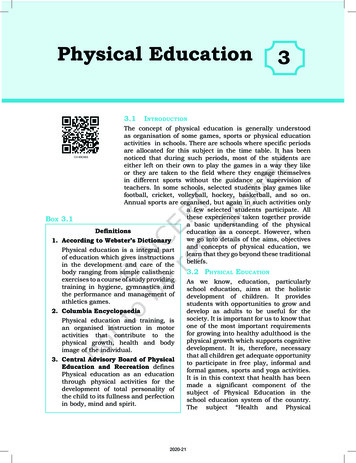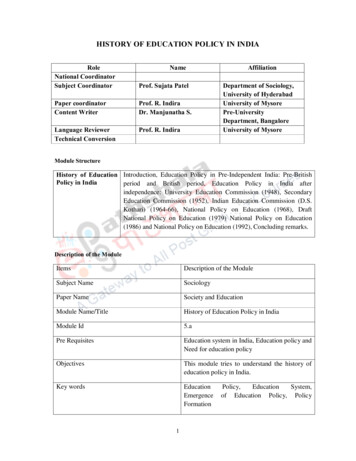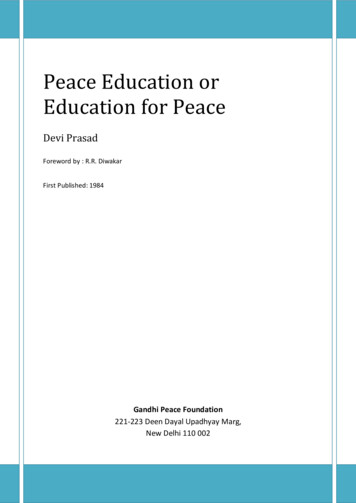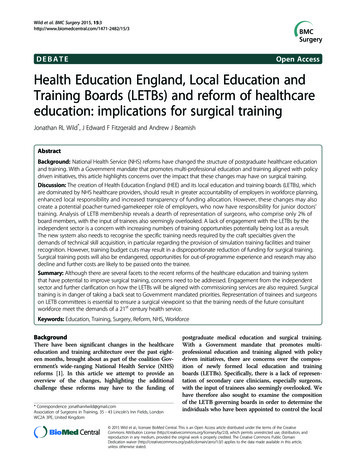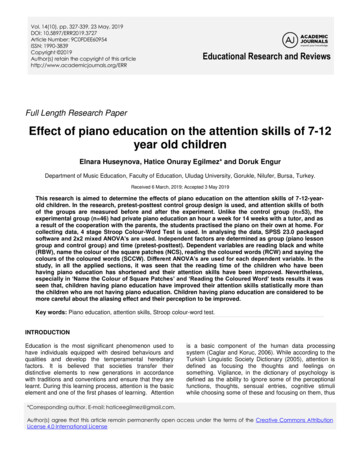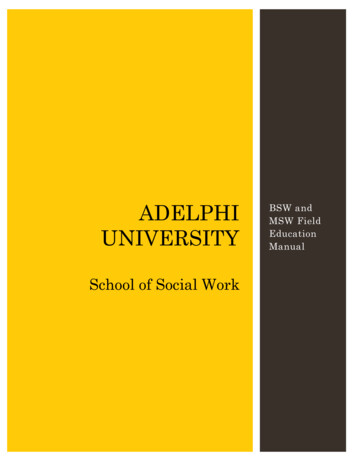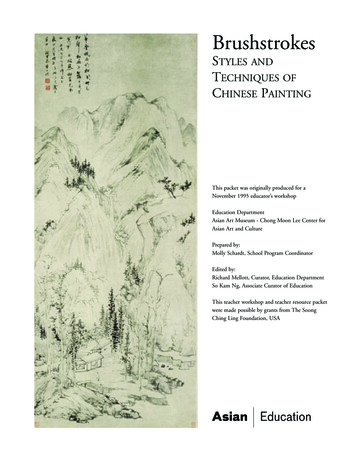
Transcription
BrushstrokesStyles andTechniques ofChinese PaintingThis packet was originally produced for aNovember 1995 educator’s workshopEducation DepartmentAsian Art Museum - Chong Moon Lee Center forAsian Art and CulturePrepared by:Molly Schardt, School Program CoordinatorEdited by:Richard Mellott, Curator, Education DepartmentSo Kam Ng, Associate Curator of EducationThis teacher workshop and teacher resource packetwere made possible by grants from The SoongChing Ling Foundation, USAAsian Art Museum
Brushstrokes: Styles and Techniques of Chinese PaintingIntroductionBrushwork is the essential characteristic of Chinese painting. Ink and brushwork provide the foundation of Chinese pictures, even when color is also used. Connoisseurs of Chinese art first notice thecharacter of the line when they view a painting. In the quality of the brushwork the artist capturesqiyun, the spirit resonance, the raison d'etre of a painting.Chinese Calligraphy and WritingIn China, painting and writing developed hand in hand, sharing the same tools and techniques. Somesort of pliant brush, capable of creating rhythmically swelling and diminishing lines, appears to havebeen invented by the Neolithic period (ca. 4500-2200 B.C.E.) where it was used to decorate potteryjars with sweeping linear patterns. By the Han dynasty (206 B.C.E.-C.E. 220), both wall paintingsand writing on strips of bamboo laced together to form books exhibit proficiency and expressivenesswith the extraordinarily resilient Chinese brush and ink.Chinese writing is composed of block-like symbols which stand for ideas. Sometimes called “ideograms,” the symbols more often are referred to as “characters.” These characters, which evolved frompictograms (simplified images of the objects they represent), were modified over time to representmore abstract concepts. Calligraphers soon codified and regularized these symbols, designing each oneto fit into an imaginary square, whether it is composed of one or sixty-four strokes. Furthermore,writers draw each of the strokes of a character in a particular order, essentially from left to right andfrom top to bottom. This information is essential for readers trying to decipher cursive script styleswhere some or all of the strokes are joined together (see Chart E).Calligraphy, the art of "beautiful writing," developed rapidly, soon yielding several forms of script.The clerical and regular scripts are made up of short, separate strokes that could be written easilywith brush and ink. As the joy of writing took hold, calligraphers invented more styles, including therunning and cursive scripts where they joined some or all of the character’s dots and lines that theywrote separately in the more formal styles (see slides 1 and 2).In writing, the Chinese seek to balance the size and relationship of one stroke with another and onecharacter with another. Creating harmony between density and sparseness, top and bottom, left andright become second nature to the practiced calligrapher. This training in formal relationships andthe use of the fluid ink and resilient brush led naturally to the translation of the art of writing tothe art of painting.1Asian Art Museum
Brushstrokes: Styles and Techniques of Chinese PaintingCalligraphy ToolsThe Chinese call the tools that were essential for writing and painting, “the Four Treasures” -- brush,ink stick, ink stone, and paper. Each of these is special to the evolution and methods of writing andpainting (see slide 3).Chinese brushes are constructed in a special way that allows them to come to a sharp point for finelines yet be fat enough for wider strokes They are capable of holding enough ink for a few longcontinuous strokes or many short ones. To make a brush tip, one or several kinds of animal hair maybe used including rabbit, wolf, goat, badger, and even the whiskers of mice. Brushmakers start with along central core of stiffer hair and then bundle around it a mantle of shorter hairs, which are in turnsurrounded by an outer layer of longer hair (see illustration). (The Chinese call these parts of the brushthe “heart,” the “belly,” and the “coat.”) The long, outer hairs come to a sharp point while the circle ofshorter hairs in the middle of the brush provide a well to hold ink. This brush tip is usually insertedinto a hollow bamboo tube, but sometimes into more elaborate handles of jade, lacquer, or even gold.Over the centuries many variations were made on this basic construction. The size of the brush as wellas the quantity and textures of the hair used varies according to the kind of lines the painter desires toproduce. Brushes vary in size from tiny, fairly stiff wolf hair brushes for outlining to immense resilientbrushes for large calligraphic scrolls. Long tapering brushes are good for swirling movements; shortstumpy ones produce a blunt line with the understated impression favored by some of the scholarpainters. Brushes of soft rabbit or goat hair are suitable for washes, and when thin, for the steadyeven lines of architecture.The next important material for the calligrapher and painter, paper, was invented in China duringthe Western Han dynasty (206 B.C.E.-C.E.9). The Chinese were avid record keepers and needed alightweight, thin, inexpensive material to write on. Early calligraphers carved records in stone, castthem in bronze, or wrote them on bamboo strips or silk, but all of these materials were too expensiveor too big and bulky for China’s exploding documentary and literary output.It was not until the Tang dynasty (618-906) that painters began to use paper on occasion, and it wasnot used extensively for pictures until the Yuan dynasty (1279-1368). (In fact, most early paintinghad been done on silk.) After this time, scholars who painted for the sheer pleasure of it came toprefer paper, viewing the material as a natural extension of their role as literary men accomplished incalligraphy. Calligraphers and painters first made paper from rags, but eventually used many kinds ofvegetable fiber including tree bark, grass, hemp, and grain husk. (The rice paper sold to foreigners wasa rather poor quality paper not used by calligraphers or painters.)Paper used for brushwork can be either sized or unsized. Papermakers sized paper by coating one sidewith alum to partially seal the paper’s pores, thus making it somewhat smoother and less absorbent.Sized paper was preferred for dry brush, contrasting ink, or fine line work. Unsized paper, in contrast,was used for wet ink painting of the expressive style.In addition to brushes and paper, the artist needed a medium, in this case ink. Chinese artists makeink from soot mixed with glue and formed into hard sticks. The finely ground soot produces the colorwhile the glue both holds the stick together and acts as an adhesive to bind the ink to the paper or2Asian Art Museum
Brushstrokes: Styles and Techniques of Chinese Paintingsilk. Pine soot, from the inner wood of the tree, produced the best all-around ink, but other kindsof soot and various animal glues have been used. Ink compounders have experimented over the ageswith different materials, sometimes adding such unlikely ingredients as pig's gall and oxhorn marrow,powdered pearls, and jade dust. In the Song dynasty (960-1279) an ink maker discovered that whenhe mixed tung oil-lamp soot, which had not previously made a good ink, with pine it produced anexceptionally deep, glossy, black ink. Sometimes scholars tried to make their own ink; Su Dongpo(1036-1101) almost burned his house down during one attempt. Most ink makers guarded theirrecipes carefully, never writing them down and passing them on only to their apprentices. Therefore,the recipes for making some special inks have been totally lost such as that for a once-popularbluish ink.To use the ink stick, painters must grind it with water on a fine grained stone. The ink stone becameone of the Four Treasures of the scholar. The quality of the stone’s grain was of the greatest importance,but stones were treasured also for their color and beauty. They were cut and carved so that they had aflat surface for grinding, perhaps with a slight lip around the edge, and a depression to hold the waterand ground ink. Sometimes they were decoratively carved as well. Fascinated with all aspects of inkpainting, scholars discussed the merits of different inks and ink stones, how much water to use whenmixing ink, and like topics in great detail.3Asian Art Museum
Brushstrokes: Styles and Techniques of Chinese PaintingThe Development of Landscape PaintingWhen we think of Chinese painting we think of hanging scrolls and handscrolls. Wall paintings werean early form of painting, preserved today in cave temples, temple buildings, and tombs. Writtenrecords describe paintings on palace walls and in humbler dwellings. One of the first advocates oflandscape painting, Zong Bing, wrote in the 5th century about the joys of having landscape paintingson the walls of his house so he could imagine himself in the untrammeled world of mountains andstreams, mists, trees, and rocks. Hanging scrolls of silk provided wall decoration that could be changedor removed. Handscrolls, primarily used for written documents, became vehicles for the illustrations ofparagons of virtue or of supernatural spirits as well as panoramic landscapes, (see slides 5 and 6) andbird and flower paintings (see slide 14).Smaller formats for painting evolved as the practice of making and giving small paintings as giftsbecame customary. Oval Chinese fans and album leaves of silk were popular in the Southern Songdynasty (1127-1279), followed by paper album leaves and fans of the Japanese folding type in the Yuan(1279-1368) and later dynasties (see slides 10 and 14).Even when color was most important in Chinese painting, brushwork played a role. In the robust,sensual, cosmopolitan Tang dynasty (618-906), Chinese painters explored all means at their disposal tocreate images describing the world around them. Figure painting was important as well as animals andbirds in natural settings. Early works about painting call the art form “making boundaries.” Outlinewas a very essential feature, and artists explored linear brushwork to give fullness, movement, andvitality to the figures. Two of these early artists Gu Kaizi and Wu Daozi, were famous for developingvery different line styles, the one using very fine but tough lines that seem to float without breaking,called "floating silk-thread lines" and the other using strong “iron wire lines” to impart a sense ofmuscle mass and energy to his figures (see Chart A and slide 12). Wang Wei (699-759) became thefirst painter to use ink only (or at least primarily) to depict a landscape scene.Later painters credited Wang with originating the use of texture strokes (cun) to fill in and givegeologic credence to his outlined mountain and rock forms (see slide 5). His landscape style with inkstrokes defining the texture of mountians and washes of ink or pale color indicating light and darkareas, presented a striking contrast to the rich blue-green mountain landscapes outlined and coloredwith the intense mineral pigments azurite and malachite of the prevailing blue-green landscape style.Gradually more and more gentlemen-scholars of the succeeding dynasties seized upon this distinctionas the standard for separating scholar-amateurs from professional artists, until in the 16th century itwas all but written in stone by the painter/theorist Dong Qichang (1555-1636).The heritage of Tang painting continued in the court styles of later dynasties perpetuating gongbi,or meticulous, style of outlines and colors on silk. At the same time the new landscape painting inink became the dominant style. In keeping with the cultural, religious, and philosophical basis inConfucianism and Taoism, the Chinese artist sought to express his vision of what is essential throughlandscape. The Taoists saw in Nature the ultimate mystery and harmony of existence. The holyman for them was the immortal; the one who was so in tune with the universe that he could live4Asian Art Museum
Brushstrokes: Styles and Techniques of Chinese Paintingforever, dwelling in the mountains, existing on dew and crushed jade. For the Confucians, Nature, asexperienced in the mountain wilderness, exhibited the perfect li, or order of the universe, after whichman should pattern his social existence. The Chinese words for “landscape,” shanshui hua, literallymean “mountain and water painting,” thus indicating the essential elements that make landscape theultimate vehicle for artistic expression.Landscape also became the first genre in which artists fully explored the many techniques ofbrushpainting. Brushstrokes, the methods of using brush and ink developed in the practice ofcalligraphy, were the artists' means to their ends. The monumental landscapes of the Five Dynasties(906-960) and Northern Song (960-1127) periods initiate the exploration of various short dots andlines used in dense concentrations to build up a viable mountain of tough and eroded rocks, clingingvegetation, running streams, and forest trees. In other words, at this time painters used brushstrokes torecreate on paper the majesty and diversity of nature. They developed a rich variety of texture strokesincluding long and short hemp fiber strokes, cloud head strokes, raveled rope, and axe-cut strokes (seeChart C). The artist holds the brush at various angles to the paper and moves his wrist differently toproduce each stroke. For instance, fine lines are produced by using the tip of the brush held vertically;the severed band stroke starts with a vertical or slightly oblique brush, turns, and ends with thebrush held with its side to the paper. The rhythmic movement of the arm and wrist are part of therhythmic vitality of a painting or a character. Wang Xizi, the 4th century calligrapher famous for hiscursive script, enjoyed watching geese because "the movement of their turning necks seemed to him toresemble the movement of a man's wrist when he is handling the brush."In this landscape tradition, painters moved from a decoratively colorful and realistic form to one thatis more restrained and conceptual. Although they still used color in light washes of blue-green andreddish-brown, painters conceived the pictures in black and white. In Chinese color theory, blackcontains all colors; thus theorists believe that people can conceive all colors in the various tones of ink.The poet-painter Su Dongpo was once criticized for painting bamboo with red ink, which the viewersaid did not represent the natural aspect of the plant. When asked what color he should have used,Su's critic replied, "Black, of course."Invasions in the north by the Jin Tartars in the 12th century forced the Song dynasty to retreat tothe south where a new court was established at Hangzhou in 1127. Under the Emperor Hui Zongthe Imperial Painting Academy already was moving in the direction of closer views of nature, both inlandscapes and in images of birds, flowers, and insects. The intent was to capture the vital life spirit ofthese subjects as well as an understanding of their true form, texture, and movement in space. Paintersproduced works in colors on silk in the meticulous gongbi style, outling the forms and applyingwashes of color smoothed out with water in many layers. Some also experimented with the loosermogu, or “boneless,” style. In this style the artist depicted a leaf or flower with only one or twostrokes of wet ink or transparent color. This left the edges of leaves or petals free of restricting outlines,enhancing their lifelikeness. (For later examples of this method see slides 15 and 16.) The academicstyle of ink painting reflected the softer landscape of the southern regions, with its broad rivers, lowhills, and misty atmosphere. Trees appear as well trimmed and trained garden specimens, with artfullybent trunks and sparse angular branches. Figures depicted in a crisp, linear style with "lines of fewerstrokes" (see Chart A) gaze out at scenery bathed in mists. Foreground rocks and distant hills are5Asian Art Museum
Brushstrokes: Styles and Techniques of Chinese Paintingdefined with broad brushwork, such as axe-cut cun and pale ink washes. This romantic academic stylewas to continue with some variation into the succeeding dynasties in the hands of professional paintersof the Zhe school and greatly influenced the style of ink painting in Japan (seeslide 17).Developing simultaneously with the academic painting of the Southern Song (1127-1279) court,was the style of the Chan Buddhist community. This form of Buddhism (known in Japan as ZenBuddhism) centered around the practice of meditation and personal disciplines designed to bring oneto sudden enlightenment, or direct apprehension of the ultimate truth. The following lines capturethe essence of Chan practice:A special transmission outside the scriptures;No dependence on words;Direct pointing to the soul of man;Seeing into one's own nature.An art of sketchy ink painting in the xieyi, or expressive style, evolved which captured the qualityof sudden enlightenment sought by the practitioners. Brushstrokes were swift and spontaneous withrough textures and strong contrasts of light and dark ink. Strokes favored in the xieyi style includesplashed ink, broken ink, and flying white or feibai (see Chart B). The Japanese imported many ofthese paintings along with the Chan religion to their country. They deeply appreciated and emulatedthe landscapes, flowers, and figures, especially those of the unorthodox patriarchs or outrageouslegendary figures of the Zen tradition (see slide 19).Literati painting (wenren hua) emerged as the cutting edge of painting styles in the following Yuandynasty (1279-1368). After the traumatic experience of being overrun by the foreign Mongols, thescholar-gentry class distanced itself from the preceding imperial establishment as well as from theforeign invaders. Refusing to serve in the new Mongol-controlled government in Beijing, many of theleading scholars retired to the country in the south where they wrote poems, studied the classics, playedthe qin, and painted. Politically disgusted with the Southern Song, whom they viewed as weak andtraitorous, they rejected the suave, lyrical, ambiguously suggestive paintings of that period and lookedback to the earlier Five Dynasties and Northern Song periods for models of complexity and rationality.(A later reflection of this style can be seen in slides 8 and 9.)The scholar-gentleman class admired the rich vocabulary of brushstrokes found in these monumentallandscapes. They collected and copied the various methods for creating texture on mountains (cun),the numerous outline patterns for suggesting different kinds of tree leaves, and the dots (dian) fordistant foliage and surface texture (see Charts C and D). Each artist, in his own way, took thestrokes found in calligraphy and the earlier paintings, changing them if necessary, to form his ownself expressive images. They viewed painting, like calligraphy, as an extension and expression of theman, not the depiction of things or nature, although nature -- and especially landscape -- remainedthe vehicle for this expression. With some exceptions the new aesthetic favored bland, not obviouslyskillful, amateur painting styles. Wu Chen, one of the Four Great Masters of the Yuan, used wet, darkink, blunt brushstrokes, and simple repetitive shapes. Critics described his paintings as "profound6Asian Art Museum
Brushstrokes: Styles and Techniques of Chinese Paintingand remote, with a leisurely and relaxed feeling." And the reclusive Ni Zan was know for his paleink, dry brush, and sparse vegetation reflecting his remote and fastidious temperament. (A richerversion of his style can be seen in slides 8 and 9.) Chao Meng fu, a leading painter and modelcalligrapher wrote:A rock should look like the "flying white,"and a tree like the "seal" stroke.In writing the bamboo leaves,one should first learn the pa-fen method.If a person understands this thoroughly,He will discover that calligraphy andpainting have always been the same.In keeping with their literary bias, Yuan dynasty scholar-painters appropriated the use of paper, thehorizontal handscroll, and the inclusion of long inscriptions on paintings. These inscriptions of old ornew poems or comments by the artist added the flavor of scholarship and antiquity to the paintings,as did the formal four-character titles which were often added (see slide 1). Paper, which had longbeen used for written records and literary works, was more receptive to movement and pressure of thebrush. The handscroll format allowed the creation of a long, unfolding composition which scholarscould read like a book with like-minded friends. The handscroll was not a painting that would everbe hung or set out for decoration.During the Ming dynasty (1368-1644), the so-called professional or academic painters continued todevelop parallel to, but were critically overshadowed by, the scholar-painters. Under the new emperor,the old Imperial Painting Academy was reestablished as the Zhe school in an attempt to revive theglory of China's past. At the beginning of this dynasty, the distinction between scholar and amateurpainting was not hard and fast. Artists like Qiu Ying and Lan Ying were able to cross from one style tothe other and use their various talents depending on the occasion (see slides 4, 10, and 11).In the late Ming dynasty, however, the artist and critic Dong Qichang drew the firm line betweenprofessional and scholar painters, clearly favoring the latter. This had a lasting effect not only on thecourse of future painting but on the reputations of painters from the past as well. Dong Qichangdivided Chinese painting into two categories: one group included literati painters of the Ming dynastyWu school in southern China and the great masters of the Northern Song dynasty; Dong describedthe works of this category as spontaneous and intuitive. Dong called the other group the NorthernSchool, which he characterized as being practiced, skillful, and belabored; included in this categorywere painters from the Zhe school. Dong’s firm stance on the status of painters embittered academicpainters like Chen Hongshou (see slide 12), a talented painter trained first in the professional schoolbut then not awarded the high degree of esteem that Dong granted to the less-trained scholar painters.Of Wang Wei, on the other hand, whom Dong considered to be the founder of the more respectedSouthern school, he wrote:It is commonly said that the painters before [Wang Wei] were not lacking in skill, but could nottransmit the spirit of a landscape. They had not yet reached that point. Mo Ch'i [Wang Wei]7Asian Art Museum
Brushstrokes: Styles and Techniques of Chinese Paintingstarted the use of wrinkles (tsun fa) and of ink washes. He started the art of expressing much bylittle (hsi-ching).Underlining his point that the object of painting is not the careful recreation of visible reality, he said:painting is no equal to mountains and water for the wonder of scenery; but mountains and water areno equal to painting for the sheer marvel of brush and ink.[Trans. by Wai Kan Ho]The variety of painting styles and moods became more diverse in the late Ming and Qing (1644-1911)dynasties. Professional painters of the decorative schools fade from importance as different interpretations of the orthodox, literati tradition dominate the concerns of the majority of painters and critics.Some follow closely the new orthodoxy, modelling their works on those of the Yuan and Ming scholarpainters. Reverberations of Ni Zan, Wu Chen, and Dong Qichang appear. The painters reuse andreorganize traditional texture strokes, leaf patterns, and dots in new and enlivened ways (see slides8, 9, 14 and 15).In the Qing dynasty the Mustard Seed Garden Manual of Painting, (1679-1701), a compendium ofmethods of painting, grouping brushstroke techniques into categories such as trees, rocks and figuresunder landscapes; flowering plants and grasses; and fur and feathers was produced. This and earliermanuals made models of the styles and brushstrokes of the ancients available to a wider audience.Now, even those without access to collections of old paintings could make use of the traditional strokevocabulary in their work. This included the Japanese, who were recipients of an influx of Chineseculture at the collapse of the Ming dynasty. A few paintings, a few artists, and the manuals of paintinggave impetus to the new nanga, "Southern School," or bunjinga, "literary man's painting," in Japan.Early experimenters with the style used the brushwork patterns in uniquely Japanese ways, creatingflattened decorative designs only loosely related to the Chinese manner (see slide 18). Later artistsapproximated Chinese painting more closely, having had more exposure to the style and perhaps evenChinese teachers. Still the Japanese preference for flattened space and decoratively arranged forms canbe detected (see slide 20).In China, artists who did not follow the conservative orthodoxy still used nature in all its various formsand moods as their starting place but turned inward for their interpretation to create personally expressive styles. With the forms of nature, they produced interior images, sometimes quite fantastic; withthe vocabulary of Chinese brushwork, they gave expression to their feelings and unique personalities.Daoji, one of the greatest of these masters, commented:When asked if I paint in the manner of the Southern or the Northern School, I reply with a heartylaugh that I do not know whether I am of a school, or the school of me; I paint in my own style.Even in the modern age, artists continue to use and interpret anew the traditional forms and brushstrokes of Chinese painting. While some modern Chinese artists adopted western models, a numberof late-Qing and post-Qing artists demonstrate the continuity and adaptability of the art of Chinesebrushstrokes. (see slides 13 and 16)8Asian Art Museum
Brushstrokes: Styles and Techniques of Chinese PaintingSlide 1Colophon [calligraphic title] by Fan Yunlin (1558-1641) for Ink FlowersXue Wu (ca. 1564-ca. 1637)Ming dynasty, dated 1615Handscroll, ink on paperB66 D22This is an image of four Chinese words or characters. They praise the work of the painter Xue Wu, asan introduction to her ink painting of flowers. Like the painting they describe, these characters werewritten in ink with a Chinese brush. The Chinese seem to have had some form of pliant brush asearly as the Neolithic period (ca. 4500-ca. 2200) with which they painted swirling lines of black andred on the large clay pots.Here on this Ming dynasty (1368-1644) scroll, the acclaimed painter and calligrapher Fan Yunlin singsthe praises of both the artist Xue Wu and her painting, using the brush to write the four-characterphrase from an older Chinese poem which can be translated as "Brilliance from a Lady's Brush." Onthe far left, the three smaller cursive characters arranged vertically are the writer's signature followedby the red impressions of his two seals.The writing is in the style known as running-cursive script, which simplifies the characters and joinsmany of their separate strokes in a continuously flowing movement of the brush. In contrast, regularscript (the printing form of Chinese) is made up of several strokes -- short dashes, dots, and longerangled strokes in which there are pauses and changes of direction.1Asian Art Museum
Brushstrokes: Styles and Techniques of Chinese PaintingSlide 2Song of the FishermanChen Xianzhang (1428-1500)Ming dynastyHanging scroll, ink on paperB68 D6Here is another scroll featuring writing. In this case thewriting is not just the title of a painting but the work ofart itself. The Greek word calligraphy (beautiful writing) refersto writing as a visual art form. This large (about 6' tall) work,entitled "The Song of the Fisherman," is mounted as a hanging scroll for wall decoration. The artist, Chen Xiangzheng,wielded the brush with vigor and freedom in a wild cursivestyle of writing. Although Chinese calligraphy is most oftenadmired for the balance and harmony created by the placement of the strokes within each character and the relationshipof one character to another, the Chinese also appreciate thewildness of some of their more eccentric artists. This scriptis cursive because it uses simplified versions of the charactersand joins most of the remaining strokes into one sweepingmovement of the brush. But Chen has gone even beyond thisdegree of abbreviation, altering the characters almost beyondrecognition. In his own idiosyncratic way he has made somecharacters very large and some tiny. While some stretch outacross the page, others are reduced to little squiggles. Whenthe brush is pressed hard onto the paper and vigorously pulledacross it, the bristles of the brush separate leaving spaces ofwhite within the stroke known as feibai or flying white.Imagine painting this piece of calligraphy with Chen. Start inthe upper right and go down each column. Remember thecharacters themselves are formed from left to right, top tobottom.What size brush did he use to paint this 6-foot-long piece ofpaper?Do you think he painted it sitting down or standing up?In the lush green mountains the rain stops;pigeons and doves come alive.Flowers, opened by early rain,face a clear morning sky.Wind and rain intoxicate the flowers,flowers intoxicate the birds,Which, under the bamboo, coo now and then.(signed) Baisha (Chen Xiangzhang)Hint: Chinese calligraphers always lay the paper on a horizontal surface: a bench, a table, or sometimes on the floor.2Asian Art Museum
Brushstrokes: Styles and Techniques of Chinese PaintingSlide 3The Four Treasures and Other Utensils for a Scholar’s DeskWriting was so valued by the Chinese that they called the most essential implements for the art The
Brushstrokes: Styles and Techniques of Chinese Painting The Development of Landscape Painting When we think of Chinese painting we think of hanging scrolls and handscrolls. Wall paintings were an earl
